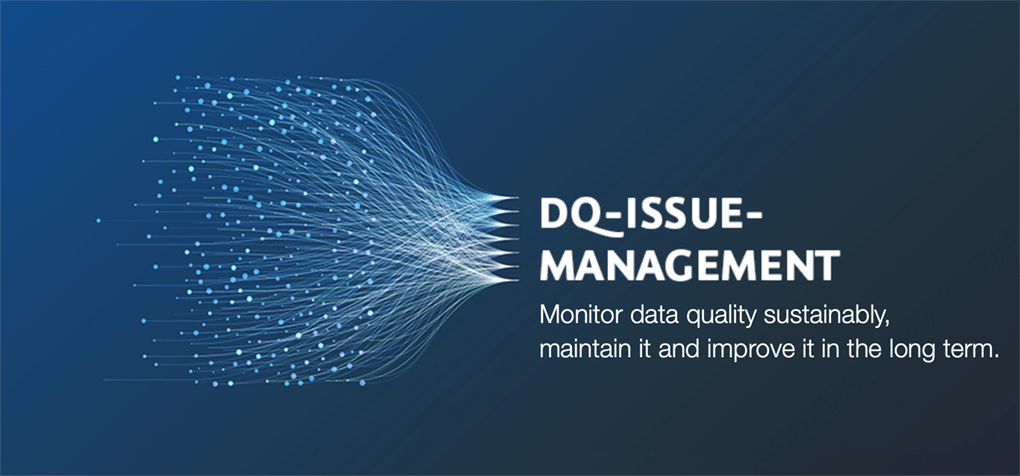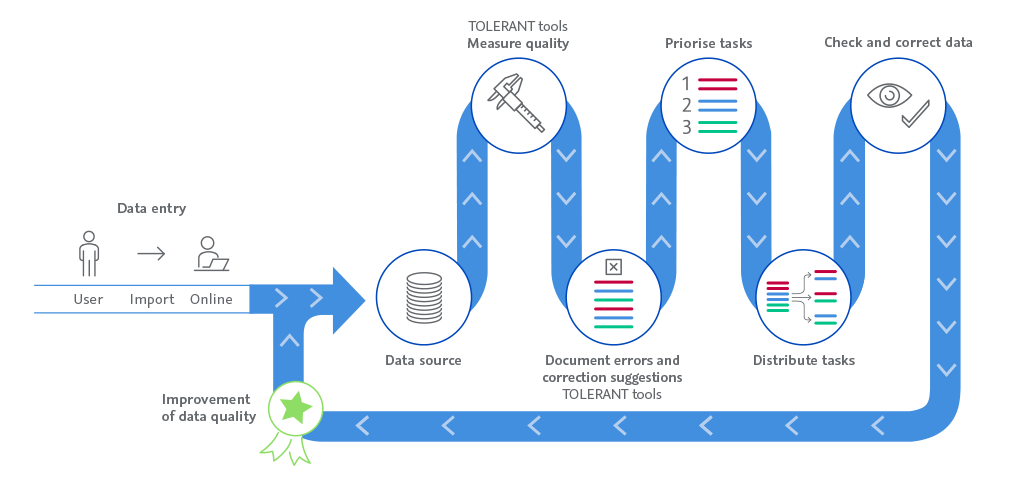Data-Quality-Issue-Management
The quality of your data is of fundamental importance to many areas of your business. Therefore, it is important to continuously monitor data quality and to improve it if necessary. This so-called DQ Issue Management works smoothly if a corresponding process is professionally designed, set up and executed.
At TOLERANT you will find the appropriate tools that serve as a basis for such processes and provide measurement results as well as correction suggestions. For some topics, even fully automated data correction with TOLERANT tools is possible. In addition, our experts have the necessary know-how and many years of experience to set up, establish and support the crucial processes.
Preventing errors in customer data:
The benefits of DQ issue management.
Continuous measurement and observation of data quality helps you keep an eye on the actual state of your data, flag faulty data for systematic cleansing, and find sources of error in the collection and processing of your data records. Long-term monitoring allows you to recognize trends and changes at an early stage and to react accordingly. If the quality of the data drops, the causes can be found in the process. You can process data errors step by step, sorted by priority.
The basis of your success: Why is DQ-issue management worthwhile?
Whether marketing measures, key figure evaluation or operational decisions: Success always depends on the underlying data quality. That’s why sustainably high data quality is a crucial basis for a company. To achieve this, data must be continuously maintained. This also enables you to identify systematic causes of errors and inaccuracies. Depending on the cause, these errors are then cleaned up manually or automatically – this is also organized and defined in DQ issue management.
A definition:
What is DQ Issue Management?
DQ Issue Management describes an organized process for measuring, evaluating, and correcting data quality issues (DQ issues) that combines automated measurement tools, process control, and manual inspection steps.
A data quality issue (DQ issue) is a quality error on a data set of your customers or business partners. Typical examples of data quality issues are:
- Invalid postal addresses
- Errors in the spelling of a name
- Incomplete names
- Duplicate entries for a customer (duplicates)
- Outdated addresses for which a relocation address is known
- Missing markings of deceased customers
- Incorrect telephone numbers
- Incorrect e-mail addresses
Multiple errors can occur per customer. Data quality tools measure each aspect of data quality. For some problems, these tools can also provide specific suggestions for correction. Even though the tools can do a lot, a manual check of automatically detected errors is useful, because the tools can also sometimes find “false errors” or miss something. The term “false positives” refers to error messages from a DQ tool that are not real errors. An example: A street in a new housing development area is not yet included in the reference data. “False negatives” are the errors in the data that were not detected by the DQ tools.
This is what you need to pay attention to:
How does DQ issue management work?
What steps are necessary for long-term high and good data quality? First, define the metrics for data quality. These include address quality, name quality, duplicates, moves, deceased, errors in phone numbers and e-mail addresses, and more. Then, create an error catalog and prioritize each error. Then define how each error will be checked and corrected. This concludes the planning of the process.
Implementation follows: Data quality is measured. The results are documented in a database with traceable reference to the individual data record. Then the results are visualized and evaluated. The errors and suggested corrections are handed over to employees for processing. They check and evaluate the errors/correction suggestions and correct them if necessary. The results of the visual inspection and the corrections are stored in white and black lists, which prevent errors that have already been processed from being marked again during repeated inspection runs. The white list contains data records that appear to be erroneous but are OK, the black list contains confirmed suspected cases that are real errors and the possible corrections. The corrected data is finally included in the data source, e.g. in your customer database.
You have the system, we have the pattern for the process: TOLERANT is your experienced partner for DQ issue management.
Our experienced experts can set up, maintain and operate efficient data quality processes for you. Our software tools provide the measurement results and correction suggestions that can be used as a basis for DQ Issue Management. We accompany and advise you in the planning, setup and development of your DQ Issue Management – suitable for your system and your processes. We show you how our software products can be integrated into your systems and processes so that you can use everything effectively in the long term. We develop a measurement control loop that fulfils your requirements: Your data is measured, reporting takes place, errors are corrected and the data is measured again. This process combines diagnosis by measurement tools with organized error correction according to priorities, divided into work packages and work distribution. Once this measurement control loop has been established, you will discover weaknesses at an early stage, which can arise in data entry due to employee changes or system errors, for example. Existing data errors are systematically reduced and you maintain a good overview of the quality of your data.



 TOLERANT Software
TOLERANT Software Shutterstock
Shutterstock